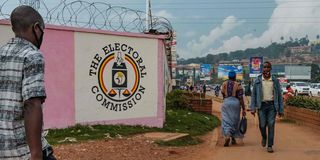An idiot’s guide to Uganda’s elections

The symbol of Uganda's Electoral Commission on a wall in Kampala, Uganda, on January 4, 2021.
Ugandans are going to the polls today to vote for the President and Members of Parliament who will serve the country until May 2026.
In spite of the election of other categories of leaders through electoral colleges, especially the Special Interest Groups and universal adult suffrage for local government elections, the main focus is on the presidential and parliamentary poll.
There are 10 men and one woman in the race for the presidency – the most coveted office in the country.
The first kind of general election to be held in Uganda was organised by the British Colonialists in 1961 as they prepared to leave Uganda ahead of independence in 1962.
Legislative Council
The election returned an African majority into the Legislative Council whereby the Democratic Party (DP), under Benedict Kiwanuka, formed the majority while Uganda Peoples Congress (UPC), led by Apollo Milton Obote, became the minority. Members of this Legislative Council travelled to London for the Lancaster House conference that made the 1961 Constitution.

Dr Milton Obote when he was sworn in as President in 1980.
In April 1962, the second election organised under the parliamentary system was held. UPC won 37 of the 82 seats in Parliament, followed by DP with exclusion of Buganda with 24 seats.
The Buganda Kingdom’s Lukiiko (Assembly) opted for an indirect election from which it nominated 21 representatives under Kabaka Yekka (KY).
Other parties that participated in this election but won no seats include the Uganda National Congress, Bataga Party of Busoga and Uganda National Union.
UPC and KY formed an alliance to form a government because it needed half of the available seats. This was the government that was to receive the instruments of Independence on October 9,1962.
Third election
Following years of turmoil after the 1966 crisis that led to the Obote I government and the emergence of Idi Amin, the third general election was held in 1980. It was also under a Parliamentary system whereby the party that wins majority seats was to form the government. This election was won by UPC.

Former Ugandan President Idi Amin.
The post-Idi Amin 1980 General Election was hoped to reset the country on a democratic path. It was mapped out during the Moshi Conference in Tanzania, convened by Ugandan exiles forced out of the country by misrule under Amin.
Museveni's emergence
The December 10 election returned 74 seats for UPC, against 51 for DP and one for Uganda Patriotic Movement (UPM) of Yoweri Museveni. The youthful UPM leader who had lost the election for the Mbarara North seat, instead went to the bush to launch a guerrilla war citing rigging in the polls.
After capturing power in 1986, Mr Museveni organised the 1989 election that led to the formation of the National Resistance Council (NRC). The number of seats in that Parliament was increased to 270.
In 1994, Ugandans again went to the ballot to elect delegates to participate in the Constituency Assembly (CA) that made the 1995 Constitution. The new Constitution would guide the country on how to hold general elections going forward.
New Constitution
The 1996 General Election was the first under the new Constitution.
Uganda had not yet returned to the multiparty system of governance and the elections were won by President Museveni in his first elective term. Five years later, Ugandans re-elected Mr Museveni in 2001 over his challenger and former aide Dr Kizza Besigye.
Another key poll in Uganda’s timeline was the national referendum of 2000 to decide whether the country would return to a multiparty system or go with the movement system. Ugandans opted for the latter by casting the ballot for the symbol of the bus against that of the dove.
However, this referendum was nullified by a court after the results were successfully challenged by DP’s Paul Kawanga Ssemogerere. Therefore, a second referendum was held in 2005 where Ugandans decided in favour of a multiparty system.
Three wins
President Museveni, under the National Resistance Movement (NRM), won all the three general elections under the multiparty system beginning with that of 2006.
Only four women have vied for the Presidency. The first was Ms Miria Kalule Obote in 2006, followed by Ms Beti Olive Kamya in 2011 and Ms Maureen Kyalya in 2016. The fourth, who happens to be the only woman in today’s ballot for the presidency, is Ms Nancy Kalembe.
Following the amendment of the Constitution by removing Article 102b in December 2017, today’s election has a cross-generational competition as the lifting of the presidential age limit has pitted 76-year-old Museveni against 24 year-old John Katumba.
Were it not for amending the Constitution, the two candidates would not be on the ballot since Museveni would be affected by the 75-year cap while and Mr Katumba would have been cut off by the 35-year rule.
President Museveni is contesting for the sixth elective term in office.





